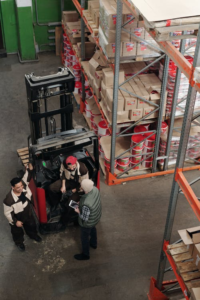There have been great advancements in the manual material handling equipment area. The movement of material from one place to another has evolved to meet modern expectations and allow workers to work efficiently.
Back in the day, workers used to lift heavy objects in wheelbarrows which were not only physically taxing but highly unsafe for the worker. It reduced overall work productivity, and there were high chances of workers getting injured, increasing the rate of absenteeism.
Here’s a history of material handling equipment
Evolution of Material Handling Equipment: From Wheelbarrows to Air Casters
Material handling equipment has transformed, and now it is much easier thanks to heavy load handling systems and ergonomic equipment moving systems. Let’s look at how we moved from wheelbarrows to air casters.
 Wheelbarrows
Wheelbarrows
Wheelbarrows were the initial equipment used back in the day of Egyptian pyramids, where individuals carried large slabs and stones from one place to another. During that period, the death rate was shockingly high, and there was a chance that employees might become physically disabled. The danger of mortality from human handling persists even in this age of innovation and technology.
According to an HSA study, over 1,400 occupational accidents occur each year, with manual handling being the primary cause of most of them. Almost 25% of workers said their employment affected their health and faced issues such as spine soreness and arm pain. Most of these workers with these concerns were in the transportation, telecommunication, and agricultural industries.
Air Casters
A mechanical device called an air caster forms an air film between the ground and the object to be lifted. Transporting heavy tools and materials is simpler because this thin layer of air decreases friction. According to a basic calculation, 1 pound of force can raise about 1000 pounds.
It comprises an air-expanded, wear-resistant piston that allows the weight to float. The weight is supported on landing sheets to prevent breaking the piston before inflation. When air is provided, the pneumatic system pumps up, creating a vacuum between the weight and the ground.
The air is spread evenly when the pressure is strong enough to balance the load. The nearly smooth, 0.003 to 0.005-inch-wide absorbent pad allows the weight to float.
Due to their circumferential movement, air casters can move huge loads without requiring frequent reconfiguration. Additionally, ceramic substrates, including polished concrete, hardwood, PVC, and raised tiles, may be easily navigated by air casters.
Why Do Factories Use Air Casters?
Several industries employ air casters due to their benefits. The top ones include:
- They provide low-cost lifting aid and reduce the chance of spinal injuries.
- There is minimal space restriction around and beneath the weight.
- They keep the atmosphere fluid and free of static.
- The “cushioning action” enables the movement of delicate items.
- To prevent fractures and breakage, they lessen floor tension.
- Compared to stationary equipment, moving machinery needs greater maintenance. Since air casters don’t have any mechanical parts, maintenance is minimal.
Get in Touch with Hovair Systems for Material Handling Equipment
If you or someone you know is looking for material handling equipment, then Hovair Systems is your best option. We are one of the leading providers of material handling equipment, offering high-quality products at affordable pricing. Our products include air casters, air pallets, air skids, air skates, and more.
Contact us today and learn more about our products.

 Wheelbarrows
Wheelbarrows